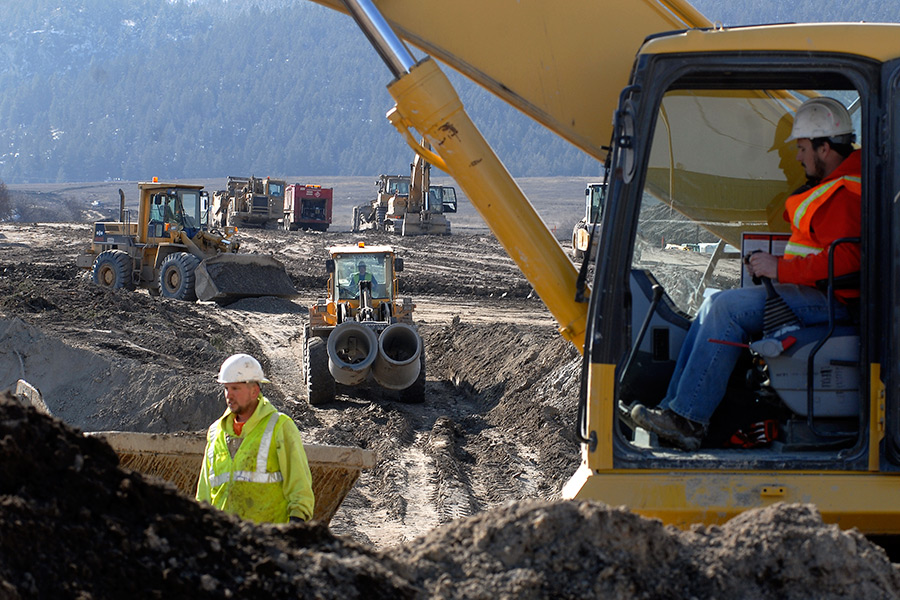The long-awaited Kalispell bypass is on track to be completed by the fall of 2017.
Or is it?
Local and state agencies have diagrammed the final phases of construction for the decades-long highway alternate route, but any progress is poised to run into a significant roadblock on May 31, when the nation’s multibillion-dollar infrastructure funding officially runs out.
Congress is preparing to address the challenging issue of how to pay for America’s massive transportation needs. Finding common ground on any topic has proven difficult in this divisive political climate, but solving this one remains especially hard because of the complexity and enormity of the situation.
The Highway Trust Fund, which is the main funding mechanism for America’s roads, bridges and other infrastructure, is drying up and failing to cover the current highway spending levels. The fund gains revenues from federal gas taxes.
The so-called Highway Bill, which includes the management plan for the trust fund, has always been a difficult piece of legislation to approve. Previous bills have called for $11 billion to $50 billion a year in federal dollars that are doled out to states. Roughly 87 percent of highway construction money in Montana comes from the federal government. Montana received $392 million in federal funding in fiscal year 2014.
The U.S. Senate and U.S. House of Representatives have struggled to agree on a long-term solution, instead passing short-term bills that maintain flat funding levels.
Faced with stalled construction projects across the U.S., lawmakers are trying to find a solution, with reports of a bipartisan effort to craft legislation that would target $170 billion in new revenue over six years.
In Kalispell, the local chamber of commerce is rallying support among business leaders to urge lawmakers to pass a comprehensive Highway Bill. Last week’s luncheon focused on the topic with a panel of state, local and private interests discussing its importance.
The state Department of Transportation has received only two-thirds of its federal funding through May 31, according to Lynn Zanto, an administrator with MDT. In 2014, MDT awarded $359 million for 132 projects statewide. Since the state has already made plans for projects through May, this means MDT officials are making contingency plans to find the remaining funding for these projects in case the Highway Bill fails. This could also impact the next set of projects that are scheduled to break ground in the coming year, Zanto said.
MDT officials estimate over the next decade the state will have $15.8 billion in transportation needs, everything from deteriorating roads to long overdue highway projects, including the South Fork Flathead River bridge replacement.
The fate of federal funding could impact more than just the bypass. City officials from Kalispell visited Washington D.C. last week gathering information and lobbying for support for a federal transportation grant that would help fund the industrial rail park off Whitefish Stage Road. The city has teamed up with Flathead County Economic Development Authority to develop the Glacier Rail Park, a 40-acre rail-served industrial park that is being developed. FCEDA and the city have fallen short the past two years but hope the third time will be the charm. The federal grant, the Transportation Investment Generating Economic Recovery (TIGER), is reauthorized through the Highway Bill. It would provide a noticeable boost to the industrial park and the city’s Core Area Revitalization Plan, which includes removing the railroad tracks through downtown.
“We consider the health of the Highway Bill and the funding of our bypass along with the transportation TIGER grant for infrastructure for the Glacier Rail Park to be our top federal priorities,” Chamber President Joe Unterreiner told the crowd at last week’s luncheon.
After decades of work, the final north phases of the bypass are designed and ready to go. The proposed roadway will construct four travel lanes and provide the final connection of the eight-mile route for traffic traveling from north to south of Kalispell with grade-separated interchanges at U.S. Highway 2, Three Mile Drive, Four Mile Drive and Old Reserve Drive (formerly Reserve Loop). The resulting phases are estimated to cost $36.6 million.
Construction is slated to commence this spring and summer.
“We can’t afford to let funding slip and we can’t afford to let time slip,” Kalispell Planning Director Tom Jentz said.
The dearth of federal funds could hurt private businesses, including contractors and engineers that tackle projects such as the bypass.
The final phases of the bypass could employ up to 150 people through construction jobs and general contracting, Jeff Claridge with LHC said.
“These are not low-paying jobs,” Claridge said.
The trickle effect of a project that size would impact hotels, restaurants and retail locations, he said.
“This is going to be an incredible project,” Claridge said. “It will really, really have a positive impact on our economy.”
